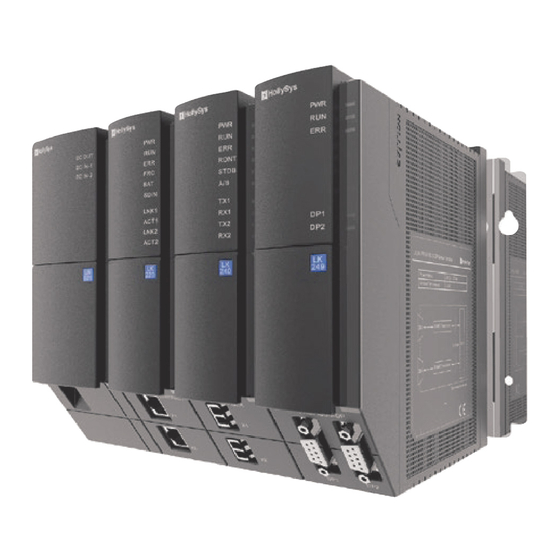
Table of Contents
Advertisement
Quick Links
Advertisement
Table of Contents
Troubleshooting

Summarization of Contents
Chapter 1 About This Book
1.1 Document Update
Details on revisions made to the manual across different versions.
1.2 Purpose
Outlines the manual's objective: to introduce the operational principles, functions, and specifications of LK PLC hardware.
1.3 Intended Audience
Identifies the target readership for the manual, including engineers and technicians.
1.4 Document Conventions
Explains conventions used in the manual for menu commands, mouse actions, and keyboard input.
1.5 Catalog
Lists related manuals and documentation for HollySys Programmable Logic Controller products.
1.6 Terminology
Defines key terms and acronyms used throughout the manual for clarity.
1.7 Abbreviations
Provides a list of abbreviations and their full names used in the manual.
Chapter 2 Overview
2.1 System characteristic
Details the key features of the LK220 Master Control Module: reliability, response, capacity, and maintenance.
2.2 Hardware components and structures
Describes the components of the LK controller system, including backplanes and modules.
2.3 Hardware Product List
Lists the LK system hardware products, including master control, communication, I/O, and power modules.
2.4 Model Selection and Planning
Guides users on selecting appropriate models based on power capacity and network considerations.
2.5 System Specification
Provides general technical specifications for the LK Series large-scale PLC system.
2.6 Product Storage and Transport
Details the optimal conditions for storing and transporting LK hardware products.
Chapter 3 Installation and Wiring
3.1 Layout Planning and Installation
Covers planning the module layout on the backboard and general installation requirements.
3.2 System Wiring
Provides detailed instructions for system power, redundancy communication, PROFIBUS-DP, and I/O wiring.
3.3 Grounding
Explains the principles of protective grounding and shield grounding for PLC systems.
Chapter 4 System Configuration
4.1 Hardware Configuration
Details the process of configuring DP Slave devices, HOLLITCP Slave devices, and MODBUS TCP protocols.
4.2 System Running
Covers required devices, device wiring, network connection, example programs, and program download.
Chapter 5 Master Control Unit
5.1 LK130 4-slot Backboard Module
Describes the LK130 backboard module, its composition, installation dimensions, and technical specifications.
5.2 LK921 24V Power Switching Module
Details the LK921 module's features, operating principle, wiring, status indication, dimensions, and specifications.
5.3 LK220 Master Control Module
Provides comprehensive information on the LK220 module: features, appearance, operating principle, status, interface, and specifications.
5.4 LK249 DP Master Station Communication Module
Covers the LK249 module's features, appearance, status indication, operating principle, terminal definition, and technical specifications.
5.5 LK240 Redundancy Communication Module
Details the LK240 module's features, appearance, dimension, status, operating principle, wiring, and technical specifications.
5.6 LK141-A Empty Module
Describes the LK141-A as an empty module used to cover unused slots on the backboard.
Chapter 6 IO Unit
6.1 Power Module
Details the LK910 24VDC Power Module, including its features, operating principle, instructions, dimensions, and specifications.
6.2 Extension Backboard
Explains the extension backboard, its interface specifications, communication address allocation, and technical details for LK117/LK118.
6.3 Communication Module
Covers various communication modules: LK232 (PROFIBUS-DP Repeater), LK233 (Optoelectronic Transceiver), LK234 (Ethernet Interface), and LK239 (MODBUS Master/Slave).
Chapter 7 IO Module
7.1 LK610 16-channel Leaking Type Digital Input Module
Details the LK610 module's features, operating principle, indicator lamps, wirings, diagnosis, protection, parameters, and specifications.
7.2 LK710 16-channel Source Type Digital Output Module
Covers the LK710 module's features, operating principle, indicator lamps, wirings, functions, over-current protection, diagnosis, and parameters.
7.3 LK410 8-Channel Voltage Type Analog Input Module
Details the LK410 module's features, operating principle, indicators, wirings, functions, diagnosis, parameters, and specifications.
7.4 LK411 8-channel Current Type Analog Input Module
Covers the LK411 module's features, operating principle, indicators, wirings, functions, diagnosis, parameters, and specifications.
7.5 LK412 6-channel Isolation Analog Input Module
Details the LK412 module's features, operating principle, indicators, wirings, functions, diagnosis, parameters, and specifications.
7.6 LK430 6-channel Thermal Resistance Analog Input Module
Covers the LK430 module's features, operating principle, indicators, wirings, functions, diagnosis, parameters, and specifications.
7.7 LK441 8-channel Thermocouple Analog Input Module
Details the LK441 module's features, operating principle, indicators, wirings, functions, diagnosis, parameters, and specifications.
7.8 LK620 2-channel counting module
Covers the LK620 module's features, operating principle, modes, indicators, wirings, functions, parameters, and technical specifications.
7.9 LK510 4-channel Inter-channel Isolated Voltage Type Analog Output Module
Details the LK510 module's features, operating principle, wirings, functions, data format, parameters, and technical specifications.
7.10 LK511 4-channel Inter-channel Isolated Current Type Analog Output Module
Covers the LK511 module's features, operating principle, indicators, wirings, functions, data format, diagnosis, parameters, and technical specifications.
Chapter 8 Accessory
8.1 LKA101 PROFIBUS-DP Bus Connector Module
Details the LKA101 connector's appearance, dimensions, operating principle, terminal matching, wiring, installation, and technical specifications.
8.2 LKA102 LK220 Battery Power Box Module
Covers the LKA102 battery module's function, appearance, installation, battery replacement, and technical specifications.
8.3 LKA103 LK220 Capacitance Power Box Module
Details the LKA103 capacitance power box module's function, appearance, installation, battery replacement, and technical specifications.
8.4 LKA104 PROFIBUS-DP Bus Connector Module
Covers the LKA104 connector's appearance, dimensions, operating principle, terminal matching, wiring, installation, and technical specifications.
8.5 LKA105 Optical Fiber
Describes the LKA105 optical fiber used for redundancy communication in master/slave frames.
Chapter 9 Fault and Treatment
9.1 Fault Mechanism
Explains the mechanisms behind serious failures, including controller, system, DP link, and power faults.
9.2 Troubleshooting Way
Provides methods for troubleshooting LK redundancy system errors: checking indicators, using AutoThink tools, and viewing diagnosis information.
9.3 Fault Phenomenon and Causes
Lists common fault symptoms, their possible causes, and corresponding treatment measures.


Need help?
Do you have a question about the LK411 and is the answer not in the manual?
Questions and answers